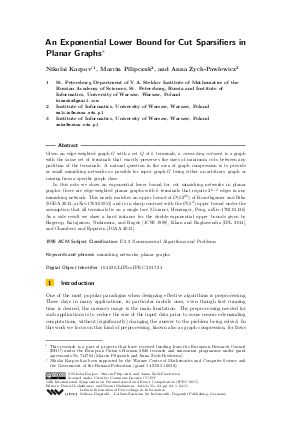An Exponential Lower Bound for Cut Sparsifiers in Planar Graphs
Authors Nikolai Karpov, Marcin Pilipczuk, Anna Zych-Pawlewicz
-
Part of:
Volume:
12th International Symposium on Parameterized and Exact Computation (IPEC 2017)
Part of: Series: Leibniz International Proceedings in Informatics (LIPIcs)
Part of: Conference: International Symposium on Parameterized and Exact Computation (IPEC) - License:
 Creative Commons Attribution 3.0 Unported license
Creative Commons Attribution 3.0 Unported license
- Publication Date: 2018-03-02
File

PDF
LIPIcs.IPEC.2017.24.pdf
- Filesize: 0.51 MB
- 11 pages
Document Identifiers
Subject Classification
Keywords
- mimicking networks
- planar graphs
Metrics
- Access Statistics
-
Total Accesses (updated on a weekly basis)
0PDF Downloads0Metadata Views
Abstract
Given an edge-weighted graph G with a set Q of k terminals, a mimicking network is a graph with the same set of terminals that exactly preserves the sizes of minimum cuts between any partition of the terminals. A natural question in the area of graph compression is to provide as small mimicking networks as possible for input graph G being either an arbitrary graph or coming from a specific graph class. In this note we show an exponential lower bound for cut mimicking networks in planar graphs: there are edge-weighted planar graphs with k terminals that require 2^(k-2) edges in any mimicking network. This nearly matches an upper bound of O(k * 2^(2k)) of Krauthgamer and Rika [SODA 2013, arXiv:1702.05951] and is in sharp contrast with the O(k^2) upper bound under the assumption that all terminals lie on a single face [Goranci, Henzinger, Peng, arXiv:1702.01136]. As a side result we show a hard instance for the double-exponential upper bounds given by Hagerup, Katajainen, Nishimura, and Ragde [JCSS 1998], Khan and Raghavendra [IPL 2014], and Chambers and Eppstein [JGAA 2013].
Cite As Get BibTex
Nikolai Karpov, Marcin Pilipczuk, and Anna Zych-Pawlewicz. An Exponential Lower Bound for Cut Sparsifiers in Planar Graphs. In 12th International Symposium on Parameterized and Exact Computation (IPEC 2017). Leibniz International Proceedings in Informatics (LIPIcs), Volume 89, pp. 24:1-24:11, Schloss Dagstuhl – Leibniz-Zentrum für Informatik (2018)
https://doi.org/10.4230/LIPIcs.IPEC.2017.24
BibTex
@InProceedings{karpov_et_al:LIPIcs.IPEC.2017.24,
author = {Karpov, Nikolai and Pilipczuk, Marcin and Zych-Pawlewicz, Anna},
title = {{An Exponential Lower Bound for Cut Sparsifiers in Planar Graphs}},
booktitle = {12th International Symposium on Parameterized and Exact Computation (IPEC 2017)},
pages = {24:1--24:11},
series = {Leibniz International Proceedings in Informatics (LIPIcs)},
ISBN = {978-3-95977-051-4},
ISSN = {1868-8969},
year = {2018},
volume = {89},
editor = {Lokshtanov, Daniel and Nishimura, Naomi},
publisher = {Schloss Dagstuhl -- Leibniz-Zentrum f{\"u}r Informatik},
address = {Dagstuhl, Germany},
URL = {https://drops.dagstuhl.de/entities/document/10.4230/LIPIcs.IPEC.2017.24},
URN = {urn:nbn:de:0030-drops-85603},
doi = {10.4230/LIPIcs.IPEC.2017.24},
annote = {Keywords: mimicking networks, planar graphs}
}
Author Details
References
- Alexandr Andoni, Anupam Gupta, and Robert Krauthgamer. Towards (1 + ε)-approximate flow sparsifiers. In Chandra Chekuri, editor, Proceedings of the Twenty-Fifth Annual ACM-SIAM Symposium on Discrete Algorithms, SODA 2014, Portland, Oregon, USA, January 5-7, 2014, pages 279-293. SIAM, 2014. URL: http://dx.doi.org/10.1137/1.9781611973402.20.
- Erin W. Chambers and David Eppstein. Flows in one-crossing-minor-free graphs. J. Graph Algorithms Appl., 17(3):201-220, 2013. URL: http://dx.doi.org/10.7155/jgaa.00291.
- Julia Chuzhoy. On vertex sparsifiers with steiner nodes. In Howard J. Karloff and Toniann Pitassi, editors, Proceedings of the 44th Symposium on Theory of Computing Conference, STOC 2012, New York, NY, USA, May 19 - 22, 2012, pages 673-688. ACM, 2012. URL: http://dx.doi.org/10.1145/2213977.2214039.
- Matthias Englert, Anupam Gupta, Robert Krauthgamer, Harald Räcke, Inbal Talgam-Cohen, and Kunal Talwar. Vertex sparsifiers: New results from old techniques. SIAM J. Comput., 43(4):1239-1262, 2014. URL: http://dx.doi.org/10.1137/130908440.
- Gramoz Goranci, Monika Henzinger, and Pan Peng. Improved guarantees for vertex sparsification in planar graphs. CoRR, abs/1702.01136, 2017. URL: http://arxiv.org/abs/1702.01136.
- Torben Hagerup, Jyrki Katajainen, Naomi Nishimura, and Prabhakar Ragde. Characterizing multiterminal flow networks and computing flows in networks of small treewidth. J. Comput. Syst. Sci., 57(3):366-375, 1998. URL: http://dx.doi.org/10.1006/jcss.1998.1592.
- Arindam Khan and Prasad Raghavendra. On mimicking networks representing minimum terminal cuts. Inf. Process. Lett., 114(7):365-371, 2014. URL: http://dx.doi.org/10.1016/j.ipl.2014.02.011.
- Stefan Kratsch and Magnus Wahlström. Representative sets and irrelevant vertices: New tools for kernelization. In 53rd Annual IEEE Symposium on Foundations of Computer Science, FOCS 2012, New Brunswick, NJ, USA, October 20-23, 2012, pages 450-459. IEEE Computer Society, 2012. URL: http://dx.doi.org/10.1109/FOCS.2012.46.
- Robert Krauthgamer and Inbal Rika. Mimicking networks and succinct representations of terminal cuts. CoRR, abs/1207.6246, 2012. URL: http://arxiv.org/abs/1207.6246.
- Robert Krauthgamer and Inbal Rika. Mimicking networks and succinct representations of terminal cuts. In Sanjeev Khanna, editor, Proceedings of the Twenty-Fourth Annual ACM-SIAM Symposium on Discrete Algorithms, SODA 2013, New Orleans, Louisiana, USA, January 6-8, 2013, pages 1789-1799. SIAM, 2013. URL: http://dx.doi.org/10.1137/1.9781611973105.128.
- Robert Krauthgamer and Inbal Rika. Refined vertex sparsifiers of planar graphs. CoRR, abs/1702.05951, 2017. URL: http://arxiv.org/abs/1702.05951.
- Konstantin Makarychev and Yury Makarychev. Metric extension operators, vertex sparsifiers and lipschitz extendability. In 51th Annual IEEE Symposium on Foundations of Computer Science, FOCS 2010, October 23-26, 2010, Las Vegas, Nevada, USA, pages 255-264. IEEE Computer Society, 2010. URL: http://dx.doi.org/10.1109/FOCS.2010.31.
